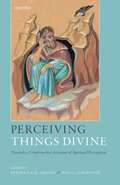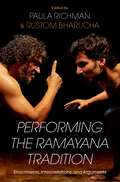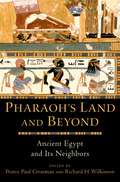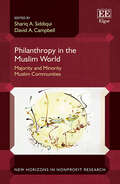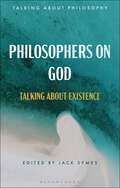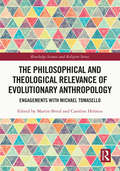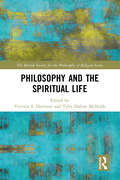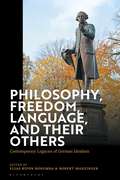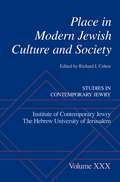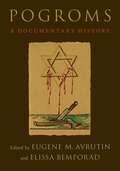- Table View
- List View
Perceiving Things Divine: Towards a Constructive Account of Spiritual Perception
Sensory language is commonly used to describe human encounters with the divine. Scripture, for example, employs perceptual language like 'taste and see that the Lord is good', 'hear the word of the Lord', and promises that 'the pure in heart will see God'. Such statements seem to point to certain features of human cognition that make perception-like contact with divine things possible. But how precisely should these statements be construed? Can the elusive notion of 'spiritual perception' survive rigorous theological and philosophical scrutiny and receive a constructive articulation? Perceiving Things Divine seeks to make philosophical and theological sense of spiritual perception. Reflecting the results of the second phase of the Spiritual Perception Project, this volume argues for the possibility of spiritual perception. It also seeks to make progress towards a constructive account of the different aspects of spiritual perception while exploring its intersection with various theological and philosophical themes, such as biblical interpretation, aesthetics, liturgy, race, ecology, eschatology, and the hiddenness of God. The interdisciplinary scope of the volume draws on the resources of value theory, philosophy of perception, epistemology, philosophy of art, psychology, systematic theology, and theological aesthetics. The volume also draws attention to how spiritual perception may be affected by such distortions as pornographic sensibility and racial prejudice. Since perceiving spiritually involves the whole person, the volume proposes that spiritual perception could be purified by ascetic discipline, healed by contemplative practices, trained in the process of spiritual direction and the pursuit of virtue, transformed by the immersion in the sacramental life, and healed by opening the self to the operation of divine grace.
Performing the Ramayana Tradition: Enactments, Interpretations, and Arguments
The Ramayana, one of the two pre-eminent Hindu epics, has played a foundational role in many aspects of India's arts and social norms. For centuries, people learned this narrative by watching, listening, and participating in enactments of it. Although the Ramayana's first extant telling in Sanskrit dates back to ancient times, the story has continued to be retold and rethought through the centuries in many of India's regional languages, such as Hindi, Tamil, and Bengali. The narrative has provided the basis for enactments of its episodes in recitation, musical renditions, dance, and avant-garde performances. This volume introduces non-specialists to the Ramayana's major themes and complexities, as well as to the highly nuanced terms in Indian languages used to represent theater and performance. Two introductions orient readers to the history of Ramayana texts by Tulsidas, Valmiki, Kamban, Sankaradeva, and others, as well as to the dramaturgy and aesthetics of their enactments. The contributed essays provide context-specific analyses of diverse Ramayana performance traditions and the narratives from which they draw. The essays are clustered around the shared themes of the politics of caste and gender; the representation of the anti-hero; contemporary re-interpretations of traditional narratives; and the presence of Ramayana discourse in daily life.
Pharaoh's Land and Beyond: Ancient Egypt and Its Neighbors
The concept of pharaonic Egypt as a unified, homogeneous, and isolated cultural entity is misleading. Ancient Egypt was a rich tapestry of social, religious, technological, and economic interconnections among numerous cultures from disparate lands. In fifteen chapters divided into five thematic groups, Pharaoh's Land and Beyond uniquely examines Egypt's relationship with its wider world. The first section details the geographical contexts of interconnections by examining ancient Egyptian exploration, maritime routes, and overland passages. In the next section, chapters address the human principals of association: peoples, with the attendant difficulties of differentiating ethnic identities from the record; diplomatic actors, with their complex balances and presentations of power; and the military, with its evolving role in pharaonic expansion. Natural events, from droughts and floods to illness and epidemics, also played significant roles in this ancient world, as examined in the third section. The final two sections explore the physical manifestations of interconnections between pharaonic Egypt and its neighbors, first in the form of material objects and second, in the powerful exchange of ideas. Whether through diffusion and borrowing of knowledge and technology, through the flow of words by script and literature, or through exchanges in the religious sphere, the pharaonic Egypt that we know today was constantly changing--and changing the cultures around it. This illustrious work represents the first synthesis of these cultural relationships, unbounded by time, geography, or mode.
Philanthropy in the Muslim World: Majority and Minority Muslim Communities (New Horizons in Nonprofit Research series)
Philanthropy plays an essential role in Muslim practice around the world. Using a new framing, Philanthropy in the Muslim World contributes to the literature by adding Muslim-majority countries that have not been previously included in cross-national philanthropy volumes as well as countries that have important Muslim minority communities.This book accomplishes five important tasks. First, it provides available research on different parts of the world where Muslims live and practice their faith and philanthropy. Second, it offers a cross-national understanding of philanthropy. Third, it illustrates the diversity and heterogeneity in philanthropic practice across different geographical contexts. It suggests that local culture, public policy, and regulations have an important role in defining local religious practice. Fourth, it helps us to understand how Muslims, in majority and minority contexts, seek to practice philanthropy after the terrorist attacks of 9/11/2001 and the Global War on Terror. Fifth, it pushes back against the notion of a ‘Muslim’ and ‘non-Muslim’ world, as these terms have little basis in either critical scholarship or Qur’anic discourse.In the academic world, the book will be important to those interested in the sociology of Islam, scholars of civil society and philanthropy, scholars interested in global philanthropy or Islam in a global context, and students in courses on Islamic faith and practice. However, this book would also be valuable for the non-scholarly educated reader including philanthropists, international NGOs, policy-makers, and practitioners who seek to understand how Muslim philanthropy can play an important role in social good interventions in different parts of the world.
Philosophers on God: Talking about Existence (Talking about Philosophy)
The origin of our universe is the greatest mystery of all. How do we find ourselves existing, let alone enveloped in a cosmos enriched with such order and complexity? For religious philosophers, despite the incredible advances of modern physics, we are no closer to a scientific explanation of where the universe came from. 'God', they affirm, 'is the best solution to the mystery.' Yet, there are those who call for patience. The new atheists remind us that science has a habit of explaining what was once unexplainable. In the meantime, we should not delude ourselves into contentment. 'Religion', they say, 'is the opium of the people and the enemy of progress. In fact, God may be the nastiest idea in human history.' This book is a short, engaging and accessible guide to the mystery of existence. Featuring remastered interviews and original essays from the world's most influential and respected thinkers, Philosophers on God explores the most fascinating and innovative research in all of philosophy and science. In doing so, it sheds new light on the nature, purpose and ultimate destination of our universe. Contributors: Susan Blackmore, William Lane Craig, Richard Dawkins, Daniel Dennett, Daniel J. Hill, Jessica Frazier, Silvia Jonas, Asha Lancaster-Thomas, Stephen Law, Casey Logue, Yujin Nagasawa, Richard Swinburne, Jack Symes, Mohammad Saleh Zarepour.
The Philosophical and Theological Relevance of Evolutionary Anthropology: Engagements with Michael Tomasello (Routledge Science and Religion Series)
This book explores the philosophical and theological significance of evolutionary anthropology and includes diverse approaches to the relationship between evolution, culture, and religion. Particular emphasis is placed on the work of Michael Tomasello, who contributes an opening chapter that tackles the role of religion in his natural history of human thinking and human morality. The first section of the book considers the philosophical foundations of evolutionary anthropology and shows that evolutionary anthropology is open to a multitude of philosophical analyses. The second part offers theological perspectives on the relationship between evolutionary and theological anthropology and between evolution and religion. The volume also reflects more broadly on the complex relationship between religion and science in the contexts of late-modern societies. It makes a significant contribution to the religion and science debate and offers performative evidence that an interdisciplinary discussion between theologians, philosophers, and natural scientists is feasible.
Philosophy and the Spiritual Life (The British Society for the Philosophy of Religion Series)
This book breaks new ground for the philosophy of religion by showcasing work that engages with the lived reality of the spiritual life. It demonstrates that philosophy’s relationship with spirituality is more than a historical curiosity and that, in the twenty-first century, it is still meaningful to think about philosophy in connection with spirituality. The chapters are organised around the following themes: spiritual practice and philosophical understanding; philosophical reflections on living a spiritual life; philosophical problems concerning the spiritual life. The first part discusses whether or not the topic of spirituality should be given a more fundamental role within the philosophy of religion, and, if so, how that might be accomplished. The second part addresses fundamental issues concerning human beings, their lives, and their self-understanding in relation to the spiritual life. The final part considers philosophical problems that emerge when discussing the spiritual life. By bringing together discussions of these topics, this volume constitutes a valuable resource for scholars in disciplines in which the spiritual life is a focus of interest, particularly philosophy, theology, and religious studies.
Philosophy, Freedom, Language, and their Others: Contemporary Legacies of German Idealism
Kantian and Hegelian conceptions of freedom guide this collection of essays that engage with the linguistic turn in continental philosophy to explore contemporary interpretations of freedom. Using a broad approach to the tradition of German Idealism, this volume considers its modern recasting of philosophy as a rigorous thinking practice with profound implications for individual and communal praxis and wellbeing.Philosophy, Freedom, Language, and its Others further cultivates and demonstrates the freedom to think and engage philosophy in a critical dialogue with other fields of inquiry. This method is exemplified in the philosophy and teaching of Professor Jere P. Surber, whom this book honors by using his interdisciplinary method as a springboard for new understandings of freedom in contemporary life. Expert scholars working in the philosophy of language, continental philosophy of religion, ancient philosophy, critical theory, and ethics engage seminal thinkers on freedom including Plato, Kant, Hegel, Kierkegaard, and Debord to provide a diverse range of perspectives on freedom. In so doing, they address the complex legacy of philosophical freedom across subjects from contemporary media and political patrimonial culture to literary imagination and the politics of Nelson Mandela.
Place in Modern Jewish Culture and Society (Studies in Contemporary Jewry)
Notions of place have always permeated Jewish life and consciousness. The Babylonian Talmud was pitted against the Jerusalem Talmud; the worlds of Sepharad and Ashkenaz were viewed as two pillars of the Jewish experience; the diaspora was conceived as a wholly different experience from that of Eretz Israel; and Jews from Eastern Europe and "German Jews" were often seen as mirror opposites, whereas Jews under Islam were often characterized pejoratively, especially because of their allegedly uncultured surroundings. Place, or makom, is a strategic opportunity to explore the tensions that characterize Jewish culture in modernity, between the sacred and the secular, the local and the global, the historical and the virtual, Jewish culture and others. The plasticity of the term includes particular geographic places and their cultural landscapes, theological allusions, and an array of other symbolic relations between locus, location, and the production of culture. The 30th volume of Studies in Contemporary Jewry includes twelve essays that deal with various aspects of particular places, making each location a focal point for understanding Jewish life and culture. Scholars from the United States, Europe, and Israel have used their disciplinary skills to shed light on the vicissitudes of the 20th century in relation to place and Jewish culture. Their essays continue the ongoing discussion in this realm and provide further insights into the historiographical turn in Jewish studies.
Pogroms: A Documentary History
From the 1880s to the 1940s, an upsurge of explosive pogroms caused much pain and suffering across the eastern borderlands of Europe. Rioters attacked Jewish property and caused physical harm to women and children. During World War I and the Russian Civil War, pogrom violence turned into full-blown military actions. In some cases, pogroms wiped out of existence entire Jewish communities. More generally, they were part of a larger story of destruction, ethnic purification, and coexistence that played out in the region over a span of some six decades. Pogroms: A Documentary History surveys the complex history of anti-Jewish violence by bringing together archival and published sources--many appearing for the first time in English translation. The documents assembled here include eyewitness testimony, oral histories, diary excerpts, literary works, trial records, and press coverage. They also include memos and field reports authored by army officials, investigative commissions, humanitarian organizations, and government officials. This landmark volume and its distinguished roster of scholars provides an unprecedented view of the history of pogroms.
Polin: Jewish Childhood in Eastern Europe (Polin: Studies in Polish Jewry #36)
Changes in childhood and children’s roles in society, and in how children participate in determining their own lives, have long been of interest to historians. Recent years have seen the emergence of new perspectives on the study of childhood, both in historical scholarship and in literary and cultural studies. Children’s experiences are now scrutinized not only as a means of examining the lives and self-representation of young individuals and their families, but also to investigate how the early experiences of individuals can shed light on larger historical questions. This volume applies both approaches in the context of Jewish eastern Europe. Historian Gershon Hundert has argued that studying the experience of children and attitudes towards coming of age offers an important corrective to the way we think of the Jewish past. This volume proves the potential of this approach in exploring many areas of historical interest. Among the topics investigated here are changes in perceptions of childhood and family, progress in the medical treatment of children, and developments in education. The work of charitable institutions is also considered, along with studies of emotion, gender history, and Polish–Jewish relations. From the First World War until after the Holocaust and the Second World War, countless children experienced traumatizing events. A special section is dedicated to their fate.
Polin: Studies in Polish Jewry, Index to Volumes 1-12 (Polin: Studies in Polish Jewry)
This consolidated index to the first twelve volumes of Polin will be a vital tool for scholars and students interested in any area of Polish Jewish studies. * Table of contents by volume-each volume at a glance * Chronological table of contents-each historical period at a glance * Index of persons-more than 4,500 people * Index of subjects-almost 6,000 detailed entries * Index of books reviewed * Index of contributors-listings of scholars and their contributions * Notes on contributors * A chronological table of Polish history * Maps Over the years, Polin has attracted contributions from many disciplines-among them architecture; economic, social, and political history; literature and film studies; Holocaust studies; rabbinic; sociology; women's studies; and Yiddish studies-and from a wide variety of viewpoints. Every period of Polish-Jewish history and every area of settlement has been covered, in more or less detail. Some topics have been the subject of ongoing debate in successive volumes, and the coverage of the different towns and geographical areas has likewise often extended through several volumes. However, only since the Littman Library began to publish Polin (starting from volume 8) have any indexes been provided. This long-awaited volume will greatly facilitate serious research in the field of Polish-Jewish studies.
Polin: Polish-Jewish Relations in North America (Polin: Studies in Polish Jewry #19)
Poland today is a very different country from the Poland of the past, yet attitudes inherited from the past continue to affect Polish–Jewish relations in the present. In Poland itself, now a free society, memories of the Jewish place in Poland’s history, long suppressed by communism, are being re-evaluated. In America the attitudes that had divided the two sides in the Old Country seemed for a long time to be becoming more entrenched. This volume—probably the first comprehensive study of Polish–Jewish relations in North America—explores how this situation came about, and also considers the efforts being made to put the resentments caused by past conflicts to one side as the influences long dominant in the Polish–Jewish relationship in North America begin to lose their formative power. The contributors deal boldly with matters at the heart of the relationship. There is an attempt to quantify the attitudes of both sides to a number of key aspects of the Holocaust, and fascinating questions are raised about how the Holocaust has distorted the perceptions that Poles and Jews have of each other, and why the Holocaust remains a problem in Polish–Jewish relations. Stereotyping is confronted head-on. There is an investigation of how crude stereotypes of Polish peasants have found their way into Jewish history textbooks, crucially affecting the disposition of American Jews towards Poland, and of how the stereotyped world of the shtetl still haunts the American Jewish imagination, with great consequences for attitudes to Poles and Polish Americans. The way in which this stereotype is challenged by realities encountered in the context of the March of the Living is provocatively discussed, along with the options for dealing with a landscape ‘poor in Jews, but rich in Jewish ruins’. A number of chapters describe attempts to overcome mutual stereotyping, including a detailed and valuable account of the National Polish American–Jewish American Council, and of the attempts that have been made to steer the Jedwabne debate in a constructive direction. These small beginnings show that it is possible to go beyond past differences and to concentrate instead on what has linked Poles and Jews in their long history. As in earlier volumes of Polin, substantial space is given, in ‘New Views’, to recent research in other areas of Polish–Jewish studies.
Polin: Making Holocaust Memory (Polin: Studies in Polish Jewry #20)
Although the reconciliation of Jewish and Polish memories of the Holocaust is the central issue in contemporary Polish–Jewish relations, this is the first attempt to examine these divisive memories in a comprehensive way. Until 1989, Polish consciousness of the Second World War subsumed the destruction of Polish Jewry within a communist narrative of Polish martyrdom and heroism. Post-war Jewish memory, by contrast, has been concerned mostly with Jewish martyrdom and heroism (and barely acknowledged the plight of Poles under German occupation). Since the 1980s, however, a significant number of Jews and Poles have sought to identify a common ground and have met with partial but increasing success, notwithstanding the new debates that have emerged in recent years concerning Polish behaviour during the Nazi genocide of the Jews that Poles had ignored for half a century. This volume considers these contentious issues from different angles. Among the topics covered are Jewish memorial projects, both in Poland and beyond its borders, the Polish approach to Holocaust memory under communist rule, and post-communist efforts both to retrieve the Jewish dimension to Polish wartime memory and to reckon with the dark side of the Polish national past. An interview with acclaimed author Henryk Grynberg touches on many of these issues from the personal perspective of one who as a child survived the Holocaust hidden in the Polish countryside, as do the three poems by Grynberg reproduced here. The ‘New Views’ section features innovative research in other areas of Polish–Jewish studies. A special section is devoted to research concerning the New Synagogue in Poznan, built in 1907, which is still standing only because the Nazis turned it into a swimming-pool. CONTRIBUTORS: Natalia Aleksiun, Assistant Professor in Eastern European Jewish History, Touo College, New York; Jolanta Ambrosewicz-Jacobs, Head, Section for Holocaust Studies, Centre for European Studies, Jagiellonian University, Kraków; curator, International Centre for Education about Auschwitz and the Holocaust, Auschwitz-Birkenau State Museum; Boaz Cohen, teacher in Jewish and Holocaust Studies, Shaanan and Western Galilee Colleges, northern Israel; Judith R. Cohen, Director of the Photographic Reference Collection, United States Holocaust Memorial Museum, Washington DC; Gabriel N. Finder, Associate Professor, Department of Germanic Languages and Literatures, University of Virginia; Rebecca Golbert, researcher; Regina Grol, Professor of Comparative Literature, Empire State College, State University of New York; Jonathan Huener, Associate Professor of History, University of Vermont; Carol Herselle Krinsky, Professor of Fine Arts, New York University; Marta Kurkowska, Lecturer, Institute of History, Jagiellonian, University, Kraków; Joanna B. Michlic, Assistant Professor, Holocaust and Genocide Program, Richard Stockton College, Pomona, New Jersey; Eva Plach, Assistant Professor of History, Wilfrid Laurier University, Waterloo, Canada; Antony Polonsky, Albert Abramson Professor of Holocaust Studies, Brandeis University and the United States Holocaust Memorial Museum, Washington DC; Alexander V. Prusin, Associate Professor of History, New Mexico Institute of Mining and Technology, Socorro; Jan Schwarz, Senior Lecturer, Department of Germanic Studies, University of Chicago; Maxim D. Shrayer, Professor of Russian and English, Chair of the Department of Slavic and Eastern Languages, Co-Director, Jewish Studies Program, Boston College; Michael C. Steinlauf, Professor of Jewish History and Culture, Gratz College, Pennsylvania; Robert Szuchta, History teacher, Stanislaw I. Witkiewicz High School, Warsaw; Joanna Tokarska-Bakir, Lecturer in Cultural Anthroplogy, Warsaw University; Chair, Department of Cultural Anthropology, Collegium Civitas, Poland; Scott Ury, Post-Doctoral Fellow, Department of Jewish History, Tel Aviv University; Bret Werb, United States Holocaust Memorial Museum, Washington DC; Seth L. Wolitz, Gale Chair of Jewish Studies and Professor of Comparative Literature,
Polin: 1968 Forty Years After (Polin: Studies in Polish Jewry #21)
In the mid-1960s, public opinion in Poland turned against the Gomulka regime for a variety of reasons. In an attempt to regain public support and divert attention from the real problems, Gomulka adopted an antisemitic stance. On 19 March 1968 he delivered a speech to party activists in which he divided Jews into three categories: 'patriotic Jews', 'Zionists', and those who were neither Jews nor Poles but 'cosmopolitans', who should 'avoid those fields of work where the affirmation of nationality is indispensable'. In consequence, nearly 15,000 Jews--a very large part of Poland's Jewish community--left for Israel, western Europe, and North America, effectively ending Jewish life in the country for over a decade. The events of 1968 were long ignored by scholars but in recent years their importance in the process which led to the collapse of communism has become increasingly evident. This volume illuminates the events that triggered the crisis, the crisis itself, and its consequences. Different aspects of this are examined by Dariusz Stola, Jerzy Eisler, and Wlodzimierz Rozenbaum, while the role of the the Polish Military Intelligence Service during 1945-1961 in precipitating the crisis is analyzed by Leszek Gluchowski.Several contributors consider the background to the crisis in terms of the concerns of the Jewish community. Audrey Kichelewski describes developments in the community between the consolidation of Gomulka's power in 1957 and the outbreak of the Six Day War. Malgorzata Melchior examines how Jews who had survived in Poland during the Second World War responded to the crisis. Joanna Wiszniewicz provides a group portrait of pupils of Jewish origin in Warsaw schools in the 1960s, a milieu from which important elements in the student opposition were drawn. Karen Auerbach sharpens the focus in her consideration of the situation of Yiddish writer Naftali Herts Kon, while Holly Levitsky describes the travails of the Jewish communist writer Sara Nomberg-Przytyk. The book also reprints the testimonies of several people who lived through these painful events: Jerzy Jedlicki, Henryk Dasko, and Miroslaw Sawicki. Bozena Szaynok analyses the rhetoric of the period and examines the role of 'Israel' in the crisis. The controversies which it still arouses are reflected in the exchange between generals Pioro and Jaruzelski concerning the impact of the purge of Jewish officers from the Polish People's Army and in the responses to the publication by Piotr Gontarczyk of a report on the role of Jacek Kuron in 1968. As in previous volumes of Polin, in the section 'New Views' substantial space is also given to new research into a variety of topics in Polish-Jewish studies. These include a study by Kalman Weiser of the Yiddishist Ideology of Noah Prylucki; an reassessment by Julian Bussgang of the role of Metropolitan Sheptytsky during the Holocaust; an account by Michael Beizer and Israel Bartal of the tragic career of Moses Schorr; an evaluation by Krzysztof Czyzewski of the work of the Polish poet Jerzy Ficowski; and a description of the reception in Poland of Art Spiegelman's Maus. CONTRIBUTORS Karen Auerbach, Israel Bartal, Michael Beizer, Teresa Bogucka, Julian Bussgang, Wojciech Czuchnowski, Krzysztof Czyzewski, Henryk Dasko, Jerzy Eisler, Leszek W. Gluchowski, Piotr Gontarczyk, Anna Jarmusiewicz, Wojciech Jaruszelski, Jerzy Jedlicki, Audrey Kichelewski, Holli Levitsky, Krzysztof Link-Lenczowski, Tomasz Lysak, Jacek Maj, Malgorzata Melchior, Joanna B. Michlic, Karol Modzelewski, Tadeusz Pioro, Wlodzimierz Rozenbaum, Maciej Rybinski, Dariusz Stola, Bozena Szaynok, Kalman Weiser, Joanna Wisniewicz, Tadeusz Witkowski, Piotr Wrobel, Rafal Ziemiewicz.
Polin: Jews in Krakow (Polin: Studies in Polish Jewry #23)
Few Polish cities have evoked more affection from their Jewish inhabitants than Kraków, and this volume brings together the work of leading historians from Israel, Poland, Great Britain, and the United States to explore how this relationship evolved. It takes as its starting point 1772, when Poland was partitioned between the Great Powers and Kraków came under Austrian rule, and examines the relationship between the Jewish minority and the Polish majority in the city in the different stages of its history down to the period of German occupation in the Second World War. An additional perspective is provided by a consideration of how Jewish life in Kraków has been remembered by Holocaust survivors, and how it is portrayed in post-war Polish literature. The main explanation for the specific nature of relations between Poles and Jews in Kraków as it emerges from these studies seems to be that Jewish acculturation to Polish culture was more pronounced in Kraków than anywhere else in Poland. The Jewish community as a whole opened itself up to contemporary currents and participated in the life of the city, above all in its cultural dimension, while nevertheless retaining a highly articulated sense of Jewish identity and unity. This meant that they were able both to defend their interests effectively and to establish links with the rest of the population from a position of strength. An additional important factor appears to have been the more tolerant atmosphere which prevailed in the Austro-Hungarian empire, which meant that ethnic tensions were less acute than elsewhere on the Polish lands. Furthermore, the fact that the city was largely pre-industrial and conservative, and was a spiritual and intellectual centre for both Catholics and Jews, may paradoxically have mitigated ethnic conflict, as did the fact that the two societies—Polish and Jewish—were largely socially separate. While the increase in antisemitism after 1935 and the consequences of the Holocaust are still etched in the minds of many, the city nevertheless has a special place in Jewish hearts and will continue to be remembered as one of the great centres of Jewish culture in east-central Europe. As in other volumes of Polin, the New Views section examines a number of important topics. These include a general investigation of the situation of the Jews in Galicia; an analysis of the position of Jewish slave labourers in the Kielce area under Nazi rule; an investigation into the resurgence after 1944 of the myth of ritual murder; and a discussion of the history of the Jewish settlement in Lower Silesia after the Second World War.
Polin: Jews and Their Neighbours in Eastern Europe Since 1750 (Polin: Studies in Polish Jewry #24)
Relations between Jews and their neighbours in eastern Europe have long been perceived, both in the popular mind and in conventional scholarship, as being in a permanent state of conflict. This volume counters that image by exploring long-neglected aspects of inter-group interaction and exchange. In so doing it broadens our understanding of Jewish history and culture, as well as that of eastern Europe. Whereas traditional historiography concentrates on the differences between Jews and non-Jews, the essays here focus on commonalities: the social, political, and economic worlds that members of different groups often shared. Shifting the emphasis in this way allows quite a different picture to emerge. Jews may have been subject to the whims of ruling powers and influenced by broader cultural and political developments, but at the same time they exerted a discernible influence on them - the social, cultural, and political spheres were ones that they not only shared, but that they also helped to create. This model of reciprocal influence and exchange has much to offer to the study of inter-group relations in eastern Europe and beyond. Designed to move the study of east European Jewry beyond the intellectual and academic discourse of difference that has long troubled scholars, this volume contributes to our perception of how members of different groups operate and interact on a multitude of different levels. The various contributions represent a wide cross-section of opinions and approaches - historical, literary, and cultural. Taken together they move our understanding of east European Jewry from the realm of the mythical to a more rational mode. In addition to essays considering interactions between Jews and Poles, other contributions examine relations between Jews and other ethnic groups (Lithuanians, Russians), discuss negotiations with various governments (Habsburg, Lithuanian, Polish, Russian, and Soviet), analyse exchanges between Jews and different cultural realms (German, Polish, and Russian), and explore how the politics of memory affects contemporary interpretations of these and related phenomena.
Polin: Jews in the Former Grand Duchy of Lithuania Since 1772 (Polin: Studies in Polish Jewry #25)
This volume of Polin, based on scholarship that has emerged since the fall of communism, is a wide-ranging contribution to the complex history of the Jews in Lithuania. Focusing on the specific character of Lithuanian Jewry, the volume opens by examining how their relationship with the surrounding society developed after 1772, both under tsarist rule and then in independent Lithuania. Moving to more recent times, the devastating impact on the Jewish community of the Soviet and Nazi occupations during the Second World War is discussed, as are the further negative consequences on Jewish life of the reoccupation of the country by the Soviets between 1944 and 1990. The volume concludes with material on the slow revival of Jewish life since the collapse of the Soviet Union and the re-emergence of an independent Lithuania, which was accompanied by the revival of many disciplines, such as the study of Jewish history, repressed by Soviet censorship. This revived interest in the country's Jewish past is now playing a key role in the broader transformation of historical memory of the post-Soviet era and the problem of coming to terms with the widespread local collaboration in Lithuania during the Holocaust - a process which has led to important scholarly advances but also to bitter controversy. Collectively, the studies in this volume contribute to a better understanding of the complex history of the Jews in Lithuania and of Lithuanian - Jewish relations and constitute a part of the necessary process of creating a more rounded and inclusive history of the country. CONTRIBUTORS Aelita Ambruleviciute, Marta Aleksandra Balinska, Egle Bendikaite, Michael Casper, Ellen Cassedy, Immanuel Etkes, David E. Fishman, Jack Jacobs, Grigory Kanovich, Saulius Suziedelis, Andrey Krotau, Larisa Lempertiene, Aearunas Liekis, Miriam Offer, Avi Ohry, Karin Ohry-Kossoy, Ausra Pazeraite, Antony Polonsky, Anna P. Ronell, Vladas Sirutavicius, Darius Staliunas, Saulius SuA iedelis, Vytautas Toleikis, Anna Verschik, Theodore R. Weeks, Mordechai Zalkin.
Polin: Jews and Ukrainians (Polin: Studies in Polish Jewry #26)
This volume provides a comprehensive and much-needed survey of the millennium-long history of Jews in the Ukrainian lands. The book challenges the stereotyped vision of the relationship between Jews and Ukrainians and offers in-depth studies of key periods and issues. The survey opens with a consideration of early Jewish settlements and the local reactions to these. The focus then moves to the period after 1569, when control of the fertile lands of Ukraine passed to the Polish nobility. Because it was largely Jews in the service of the nobility who administered these lands, they were inevitably caught up in the resentment that Polish rule provoked among the local population, and, above all, among the Cossacks and peasant-serfs. This resentment culminated in the great revolt led by Bohdan Khmelnytsky in the mid-17th century, in consequence of which the Jews were excluded from that part of Ukraine which eventually came under Russian rule when the Polish-Lithuanian Commonwealth was partitioned. The Jewish response to the establishment of Russian and Austrian rule in the areas of Ukraine that had formerly been in the Polish-Lithuanian Commonwealth is a second major theme of the book, and particularly the Jewish reaction to the emergence of Ukrainian nationalism and the subsequent Ukrainian struggle for independence. A third overarching theme is the impact of the sovietization of Ukraine on Jewish-Ukrainian relations, with a chapter devoted to the 1932-33 Famine (Holodomor) in which millions perished. The book also gives special attention to the growing rift between Jews and Ukrainians triggered by the rise of radical nationalism among Ukrainians living outside the Soviet Union and by conflicting views of Germany's genocidal plans regarding the Jews during World War II. With contributions from leading Jewish and Ukrainian scholars on these complex and highly controversial topics, the book places Jewish-Ukrainian relations in a broader historical context and adds to the growing literature that seeks to go beyond the old paradigms of conflict and hostility. CONTRIBUTORS: Howard Aster, formerly taught Political Science, McMaster University; Rachel Feldhay Brenner, Max and Frieda Weinstein-Bascom Professor of Jewish Studies and Professor of Modern Hebrew Literature, University of Wisconsin-Madison; Ivan Dzyuba, Ukrainian writer and literary critic; member, National Academy of Science of Ukraine; former Ukrainian Minister of Culture; Amelia Glaser, Associate Professor of Russian and Comparative Literature, University of California, San Diego; John-Paul Himka, Professor, Department of History, University of Alberta; Judith Kalik, teaches East European History, Hebrew University of Jerusalem; Myron Kapral, Director, Lviv Branch, Hrushevsky Institute of Ukrainian Archaeography and Source Studies, National Academy of Sciences of Ukraine; Vladimir (Ze'ev) Khanin, Chief Adviser on Research and Strategic Planning, Ministry of Absorption, Israel; Victoria Khiterer, Assistant Professor of History and Director, Conference on the Hilocaust and Genocide, Millersville University, Pennsylvania; Taras Koznarsky, Associate Professor, University of Toronto Sergey R. Kravtsov, Research Fellow, Center for Jewish Art, Hebrew University of Jerusalem; Taras Kurylo, independent scholar, Calgary; Alexander J. Motyl, Professor of Political Science, Rutgers University-Newark; Jakub Nowakowski, Director, Galicia Jewish Museum, Kraków; Alexander Pereswetoff-Morath, Associate Professor and Academy Research Fellow, Royal Swedish Academy of Letters, History, and Antiquities, Stockholm; Yohanan Petrovsky-Shtern, Crown Family Professor of Jewish Studies and Professor of Jewish History, Northwestern University; Antony Polonsky, Albert Abramson Professor of Holocaust Studies, Brandeis University and United States Holocaust Memorial Museum; Peter J. Potichnyj, Honorary Professor, East China University, Shanghai and Lviv Polytechnic National University; Professor Emeritus, McMaster University; Mykola Ryabchuk, Ukrainian writer and journalist; Vice President, Ukra
Polin: Jews in the Kingdom of Poland, 1815-1918 (Polin: Studies in Polish Jewry #27)
The Kingdom of Poland, also known as the Congress Kingdom or Russian Poland, was created by a decision of the Congress of Vienna as part of its attempt to set up a post-Napoleonic European order. It incorporated lands that for many decades had been the most important centres of Polish politics, finance, education, and culture, and which also had the largest concentration of Jews in eastern Europe. Because of these factors, and because its semi-autonomous status allowed for the development of a liberal policy towards Jews quite different from that of Russia proper, the Kingdom of Poland became a fertile ground for the growth of Jewish cultural and political movements of all sorts, many of which continue to be influential to this day. This volume brings together a wide range of scholars to present a broad view of the Jewish life of this important area at a critical moment in its history. In the nineteenth century, tradition vied with modernization for Jews’ hearts and minds. In the Kingdom of Poland, traditional hasidic leaders defied the logic of modernization by creating courts near major urban centres such as Warsaw and Łódź and shtiblekh within them, producing innovative and influential homiletic literature and attracting new followers. Modernizing maskilim, for their part, found employment as government officials and took advantage of the liberal climate to establish educational institutions and periodicals that similarly attracted followers to their own cause and influenced the development of the Jewish community in the Kingdom in a completely different direction. Their immediate successors, the Jewish integrationists, managed to gain considerable power within the Jewish community and to create a vibrant and more secular Polish Jewish culture. Subsequently Zionism, Jewish socialism, and cultural autonomy also became significant forces. The relative strength of each movement on the eve of the rebirth of Poland is extremely difficult to measure, but unquestionably the ferment of so many potent, competing movements was a critical factor in shaping the modern Jewish experience.
Polin: Poland and Hungary: Jewish Realities Compared (Polin: Studies in Polish Jewry #31)
At the beginning of the twentieth century, the Jewish communities of Poland and Hungary were the largest in the world and arguably the most culturally vibrant, yet they have rarely been studied comparatively. Despite the obvious similarities, historians have mainly preferred to highlight the differences and emphasize instead the central European character of Hungarian Jewry. Collectively, these essays offer a different perspective. The volume has five sections. The first compares Jewish acculturation and integration in the two countries, analysing the symbiosis of magnates and Jews in each country’s elites and the complexity of integration in multi-ethnic environments. The second considers the similarities and differences in Jewish religious life, discussing the impact of Polish hasidism in Hungary and the nature of ‘progressive’ Judaism in Poland and the Neolog movement in Hungary. Jewish popular culture is the theme of the third section, with accounts of the Jewish involvement in Polish and Hungarian cabaret and film. The fourth examines the deterioration of the situation in both countries in the interwar years, while the final section compares the implementation of the Holocaust and the way it is remembered. The volume concludes with a long interview with the doyen of historians of Hungary, István Deák.
Polin: Jews and Music-Making in the Polish Lands (Polin: Studies in Polish Jewry #32)
With its five thematic sections covering genres from cantorial to classical to klezmer, this pioneering multi-disciplinary volume presents rich coverage of the work of musicians of Jewish origin in the Polish lands. It opens with the musical consequences of developments in Jewish religious practice: the spread of hasidism in the eighteenth century meant that popular melodies replaced traditional cantorial music, while the greater acculturation of Jews in the nineteenth century brought with it synagogue choirs. Jewish involvement in popular culture included performances for the wider public, Yiddish songs and the Yiddish theatre, and contributions of many different sorts---technical and commercial as well as creative---in the interwar years. Chapters on the classical music scene cover Jewish musical institutions, organizations, and education; individual composers and musicians; and a consideration of music and Jewish national identity. One section is devoted to the Holocaust as reflected in Jewish music, and the final section deals with the afterlife of Jewish musical creativity in Poland, particularly the resurgence of interest in klezmer music. The essays in this collection do not attempt to to define what may well be undefinable---what ‘Jewish music’ is. Rather, they provide an original and much-needed exploration of the activities and creativity of ‘musicians of the Jewish faith’.CONTRIBUTORS: Eliyana R. Adler, Michael Aylward, Sławomir Dobrzański, Paula Eisenstein-Baker, Beth Holmgren, Sylwia Jakubczyk-Ślęczka, Daniel Katz, James Loeffler, Michael Lukin, Filip Mazurczak, Bożena Muszkalska, Julia Riegel, Ronald Robboy, Robert Rothstein, Joel E. Rubin, Adam J. Sacks, Amanda (Miryem-Khaye) Seigel, Eleanor Shapiro, Carla Shapreau, Tamara Sztyma, Bella Szwarcman-Czarnota, Joseph Toltz, Maja Trochimczyk, Magdalena Waligórska, Bret Werb, Akiva Zimmerman
Polin: Jewish Religious Life in Poland since 1750 (Polin: Studies in Polish Jewry #33)
Following tremendous advances in recent years in the study of religious belief, this volume adopts a fresh understanding of Jewish religious life in Poland. Approaches deriving from the anthropology, history, phenomenology, psychology, and sociology of religion have replaced the methodologies of social or political history that were applied in the past, offering fascinating new perspectives. The well-established interest in hasidism continues, albeit from new angles, but topics that have barely been considered before are well represented here too. Women’s religious practice gains new prominence, and a focus on elites has given way to a consideration of the beliefs and practices of ordinary people. Reappraisals of religious responses to secularization and modernity, both liberal and Orthodox, offer more nuanced insights into this key issue. Other research areas represented here include the material history of Jewish religious life in eastern Europe and the shift of emphasis from theology to praxis in the search for the defining quality of religious experience. The contemporary reassessments in this volume, with their awareness of emerging techniques that have the potential to extract fresh insights from source materials both old and new, show how our understanding of what it means to be Jewish is continuing to expand.
Polin: Jewish Self-Government in Eastern Europe (Polin: Studies in Polish Jewry #34)
Few features have shaped east European Jewish history as much as the extent and continuity of Jewish self-rule. Offering a broad perspective, this volume explores the traditions, scope, limitations, and evolution of Jewish self-government in the Polish lands and beyond. Extensive autonomy and complex structures of civil and religious leadership were central features of the Jewish experience in this region, and this volume probes the emergence of such structures from the late medieval period onwards, looking at the legal position of the individual community and its role as a political actor. Chapters discuss the implementation of Jewish law and the role of the regional and national Jewish councils which were a remarkable feature of supra-communal representation in the Polish–Lithuanian Commonwealth.The volume reflects on the interaction between Jewish legal traditions and state policies, and offers an in-depth analysis of the transformation of Jewish self-government under the impact of the partitions of Poland–Lithuania and the administrative principles of the Enlightenment. Co-operation between representatives of the Jewish and non-Jewish communities at the local level is discussed down to the interwar years, when Jewish self-government was considered both a cherished legacy of pre-partition autonomy and a threat to the modern nation state.
Polin: Promised Lands: Jews, Poland, and the Land of Israel (Polin: Studies in Polish Jewry #35)
An in-depth and multifaceted investigation of how Polish Jews, Polish Zionism, and Polish culture influenced Israel’s cultural and political development, as well as of how the Zionist project influenced Jewish life in Poland. From its inception as a political movement, Zionism had as its main goal the creation of a ‘New Jew’ who could contribute to building a Jewish state, preferably in the historic homeland of the Jewish people, where Jews would free themselves from the negative characteristics which, in the view of the ideologues of Zionism, had developed in the diaspora. Yet, inevitably, those who settled in Palestine brought with them considerable cultural baggage. A substantial proportion of them came from the Polish lands, and their presence significantly affected the political and cultural life of the Yishuv, and later the State of Israel. In this volume, scholars from Israel, Poland and elsewhere in Europe, and North America explore different aspects of this influence, as well as the continuing relationship between Israel and Poland, up to the present day.
